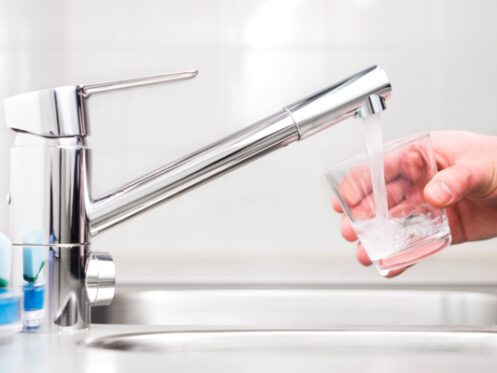Kitchen and bathroom faucets are designed to last quite a long time. Still, there will eventually be a time when you’ll need to have your faucet replaced. In some cases, you’ll want to replace your faucet for aesthetic reasons because it is damaged or rusted. The internal components of a faucet can also wear out over time and lead to issues like dripping, leaking or spraying. Here are some of the most common issues and signs that can indicate when it is time to have your faucet replaced.
1. Faucet Constantly Drips
A faucet that continually drips can be quite annoying, but the bigger issue is that a dripping faucet can waste a huge amount of water over time. A faucet that drips once per second will waste around 7 gallons of water per day on average. This may not sound like that much, but it can quickly add up. If your faucet drips continuously for a whole year, it could waste nearly 3,000 gallons of water or the equivalent of around 150 extra showers in a year.
Depending on the type of faucet, a plumber may be able to fix it quite easily and stop it from dripping. Most faucets are cartridge faucets, which means they have an internal cartridge valve that adjusts the flow of hot and cold water when you move the faucet handle. This cartridge valve often wears out over time, and this can lead to the faucet constantly dripping when it is shut off.
Replacing a worn-out cartridge valve is a fairly simple task. However, if your faucet is quite old or the other internal components are also beginning to wear out, it is usually better to replace the faucet itself instead. There are also times when replacing the cartridge valve won’t fully solve the problem. As such, if you’ve already attempted to have it repaired and your faucet continues to drip, you’re best off having a new one installed.
2. Water Leaks From the Handle or Base Whenever the Faucet Is On
Water leaking out of the faucet handle or around the base usually indicates that the internal components are starting to wear out or that something inside the faucet needs to be tightened. A faucet can also start to leak underneath the sink where the water lines feed into it, and this is a potentially more serious issue since it could lead to extensive water damage or allow mold to start growing.
As with a dripping faucet, a faucet that leaks can often be repaired depending on the specific cause. However, if the faucet is older, it may soon start to leak again. As such, we would usually recommend replacing the faucet if it ever does start to leak.
3. Water Spits or Sprays From Faucet When On
The water from your faucet should always flow in a nice, steady stream. If the faucet spits or sprays water, it usually means that its aerator is clogged with mineral deposits and sediment. The aerator can also crack and lead to water spraying out the side of it.
The aerator is the metal piece at the very end of the faucet spout, and it serves a few important purposes. Inside the aerator is a screen that catches any debris that may have gotten into the water. The aerator also reduces the pressure so that less water flows and the water won’t spray everywhere when washing your hands or doing the dishes.
Depending on the model of the faucet, the aerator will either screw to the inside or the outside of the faucet spout. The aerator can be removed for cleaning or if it needs to be replaced. However, if it screws inside the spout, you will typically need a special faucet key to take it off.
If your faucet does spit or spray water, the first thing to do is try to clean it to remove any mineral deposits and sediment from the screen. The best way to do this is to soak the aerator in undiluted white vinegar for around an hour and then use a toothbrush to clean the screen. If you can’t remove the aerator, you can also fill a plastic baggie with vinegar and tie it to the end of the aerator so you can still soak it. If cleaning the aerator doesn’t fix the problem, then it’s probably time to install a new faucet.
4. Visible Rust, Corrosion or Mineral Deposits
Rust or extensive mineral deposits are more of an aesthetic issue, but they can also impact the ability of the faucet to work properly. If the handle begins to rust, it could potentially break when you turn the faucet on and lead to water spraying everywhere. Another thing to consider is that rust and mineral deposits tend to build up inside the faucet before they affect the outside. This means that if your faucet has lots of visible rust and limescale, the problem is probably far worse on the inside and your faucet may not last much longer.
5. Squeaking or Other Unusual Noises
If your faucet handle squeaks when you turn it on and off, it usually means the internal faucet stem is wearing out. The stem can be replaced, but if the stem is worn out, then it is likely that some of the other components are also wearing out. Squealing and screeching sounds can also be related to a worn-out faucet stem, damaged or worn rubber washers or because the inside of the faucet is seriously clogged with limescale. Some of these issues can be fixed, but it is still typically best to simply replace the entire faucet.
6. Low Water Pressure
If all of your faucets have low water pressure, you can be fairly certain there is an issue with your plumbing. It could be something simple like your main water shut-off valve not being fully open or a broken pressure-reducing valve. If your home has hard water, low water pressure can also indicate that the inside of your main water line is coated in a thick layer of limescale.
If you only have low water pressure at one faucet, it usually means that either the faucet itself or the water lines that feed it are clogged with limescale. In this case, you will either need to have the faucet or the pipes replaced to fix the issue.
7. Age
A new faucet will typically last for around 20 to 25 years. If your faucet is older than this, we would always recommend replacing it instead of trying to repair any issues. Installing a new faucet will help to avoid leaks and other problems, and it may also help you save a bit on your water bills as newer faucets typically have a lower flow rate than old faucets.
If you need to have your faucet repaired or replaced, Laury Heating Cooling & Plumbing has you covered. We specialize in all types of plumbing repair, maintenance and installation services, and our team can also assist with all of your home’s heating and cooling needs. For more information or to schedule any plumbing or HVAC service in the Pennsville or Vineland areas, give us a call today.



